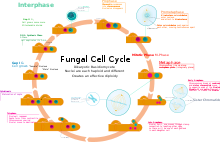Dikaryon
The dikaryon is a
hyphae by synchronously dividing so that pairs are passed to newer cells. In the Ascomycota this attribute is most often found in the ascogenous hyphae and ascocarp while the bulk of the mycelium remains monokaryotic. In the Basidiomycota this is the dominant phase, with most Basidiomycota monokaryons
weakly growing and short-lived.

The formation of a dikaryon is a
plesiomorphic character for the subkingdom Dikarya, which consists of the Basidiomycota and the Ascomycota. The formation of croziers in the Ascomycota and of clamp connections in the Basidiomycota facilitates maintenance of the dikaryons. However, some fungi in each of these phyla
have evolved other methods for maintaining the dikaryons, and therefore neither croziers nor clamp connections are ubiquitous in either phylum.
Etymology
The name dikaryon comes from the Greek δι- (di-) meaning "two" and κάρυον (karyon) meaning "nut", referring to the cell nucleus.
See also
- Binucleated cells (as a pathological state)
- Heterokaryon
- Multinucleated cells
- Syncytium
References
- ^ van den Hoek, C., D.G. Mann, and H.M. Jahns 1995. Algae: an introduction to phycology, p. 430. Cambridge University Press (623 pp).
- .
External links
